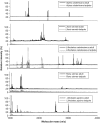Life history linked to immune investment in developing amphibians
- PMID: 27928507
- PMCID: PMC5001151
- DOI: 10.1093/conphys/cow025
Life history linked to immune investment in developing amphibians
Abstract
The broad diversity of amphibian developmental strategies has been shaped, in part, by pathogen pressure, yet trade-offs between the rate of larval development and immune investment remain poorly understood. The expression of antimicrobial peptides (AMPs) in skin secretions is a crucial defense against emerging amphibian pathogens and can also indirectly affect host defense by influencing the composition of skin microbiota. We examined the constitutive or induced expression of AMPs in 17 species at multiple life-history stages. We found that AMP defenses in tadpoles of species with short larval periods (fast pace of life) were reduced in comparison with species that overwinter as tadpoles and grow to a large size. A complete set of defensive peptides emerged soon after metamorphosis. These findings support the hypothesis that species with a slow pace of life invest energy in AMP production to resist potential pathogens encountered during the long larval period, whereas species with a fast pace of life trade this investment in defense for more rapid growth and development.
Keywords: Antimicrobial peptides; MALDI-TOF mass spectrometry; disease ecology; innate immunity; life-history strategy; tadpoles.
Figures



Similar articles
-
Interactive effects of competition and predator cues on immune responses of leopard frogs at metamorphosis.J Exp Biol. 2014 Feb 1;217(Pt 3):351-8. doi: 10.1242/jeb.091611. Epub 2013 Oct 10. J Exp Biol. 2014. PMID: 24115058
-
Hybrid advantage in skin peptide immune defenses of water frogs (Pelophylax esculentus) at risk from emerging pathogens.Infect Genet Evol. 2012 Dec;12(8):1854-64. doi: 10.1016/j.meegid.2012.07.024. Epub 2012 Aug 24. Infect Genet Evol. 2012. PMID: 22940461
-
Distribution and reproductive plasticity of Gyrinicola batrachiensis (Oxyuroidea: Pharyngodonidae) in tadpoles of five anuran species.Parasitol Res. 2018 Feb;117(2):461-470. doi: 10.1007/s00436-017-5723-4. Epub 2017 Dec 26. Parasitol Res. 2018. PMID: 29280071
-
The importance of antimicrobial peptides (AMPs) in amphibian skin defense.Dev Comp Immunol. 2023 May;142:104657. doi: 10.1016/j.dci.2023.104657. Epub 2023 Feb 6. Dev Comp Immunol. 2023. PMID: 36754220 Review.
-
The role of amphibian antimicrobial peptides in protection of amphibians from pathogens linked to global amphibian declines.Biochim Biophys Acta. 2009 Aug;1788(8):1593-9. doi: 10.1016/j.bbamem.2009.03.008. Epub 2009 Mar 25. Biochim Biophys Acta. 2009. PMID: 19327341 Review.
Cited by
-
The skin microbiota of the axolotl Ambystoma altamirani is highly influenced by metamorphosis and seasonality but not by pathogen infection.Anim Microbiome. 2022 Dec 12;4(1):63. doi: 10.1186/s42523-022-00215-7. Anim Microbiome. 2022. PMID: 36503640 Free PMC article.
-
When Defenses Fail: Atelopus zeteki Skin Secretions Increase Growth of the Pathogen Batrachochytrium dendrobatidis.Integr Comp Biol. 2022 Dec 30;62(6):1595-1605. doi: 10.1093/icb/icac060. Integr Comp Biol. 2022. PMID: 35640912 Free PMC article.
-
Gene expression differs in susceptible and resistant amphibians exposed to Batrachochytrium dendrobatidis.R Soc Open Sci. 2018 Feb 28;5(2):170910. doi: 10.1098/rsos.170910. eCollection 2018 Feb. R Soc Open Sci. 2018. PMID: 29515828 Free PMC article.
-
Exposure to Batrachochytrium dendrobatidis affects chemical defences in two anuran amphibians, Rana dalmatina and Bufo bufo.BMC Ecol Evol. 2021 Jul 3;21(1):135. doi: 10.1186/s12862-021-01867-w. BMC Ecol Evol. 2021. PMID: 34217227 Free PMC article.
-
Identification of Bufadienolides from the Boreal Toad, Anaxyrus boreas, Active Against a Fungal Pathogen.Microb Ecol. 2017 Nov;74(4):990-1000. doi: 10.1007/s00248-017-0997-8. Epub 2017 Jun 19. Microb Ecol. 2017. PMID: 28631214
References
-
- Abu Bakar A, Bower DS, Stockwell MP, Clulow S, Clulow J, Mahoney MJ (2016) Susceptibility to disease varies with ontogeny and immunocompetence in a threatened amphibian. Oecologia, Early View: 1–13DOI:10.1007/s00442-016-3607-4 - DOI - PubMed
-
- Alford RA. (1999) Ecology: resource use, competition, and predation In McDiarmid RW, Altig R, eds, Tadpoles: the Biology of Anuran Larvae. The University of Chicago Press, Chicago, pp 240–278.
-
- Alford RA, Harris RN (1988) Effects of larval growth history on anuran metamorphosis. Am Nat 131: 91–106.
-
- Apponyi MA, Pukala TL, Brinkworth CS, Maselli VM, Bowie JH, Tyler MJ, Booker GW, Wallace JC, Carver JA, Separovic F et al. (2004) Host-defence peptides of Australian anurans: structure, mechanism of action and evolutionary significance. Peptides 25: 1035–1054. - PubMed
-
- AmphibiaWeb: information on amphibian biology and conservation. [Web application. ] (2016) AmphibiaWeb, Berkeley, CA, USA. http://amphibiaweb.org/
LinkOut - more resources
Full Text Sources
Other Literature Sources

